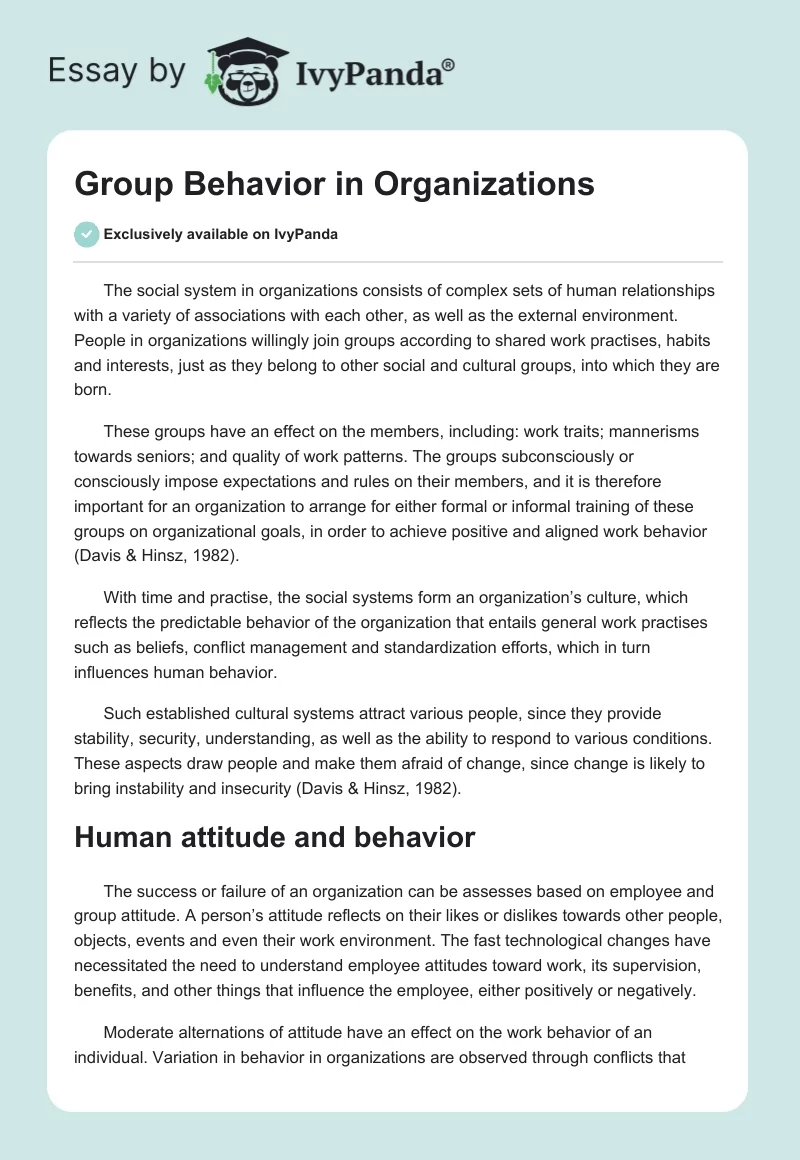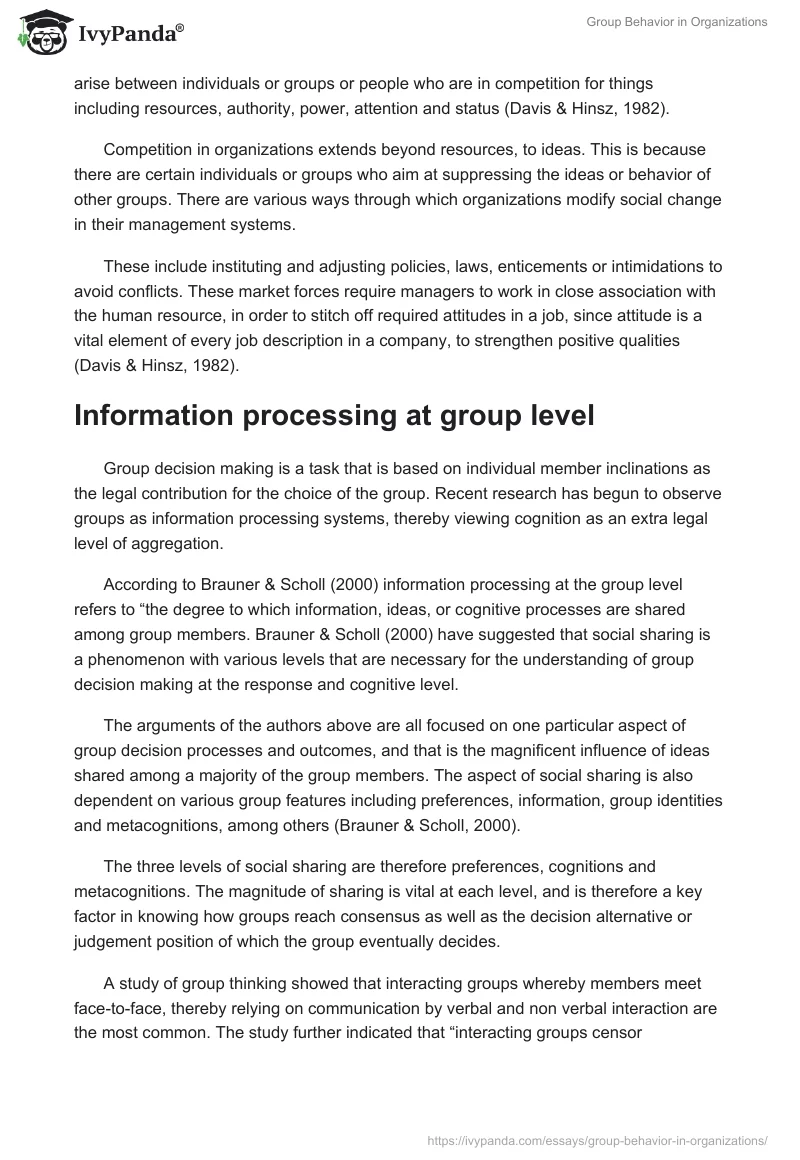The social system in organizations consists of complex sets of human relationships with a variety of associations with each other, as well as the external environment. People in organizations willingly join groups according to shared work practises, habits and interests, just as they belong to other social and cultural groups, into which they are born.
These groups have an effect on the members, including: work traits; mannerisms towards seniors; and quality of work patterns. The groups subconsciously or consciously impose expectations and rules on their members, and it is therefore important for an organization to arrange for either formal or informal training of these groups on organizational goals, in order to achieve positive and aligned work behavior (Davis & Hinsz, 1982).
With time and practise, the social systems form an organization’s culture, which reflects the predictable behavior of the organization that entails general work practises such as beliefs, conflict management and standardization efforts, which in turn influences human behavior.
Such established cultural systems attract various people, since they provide stability, security, understanding, as well as the ability to respond to various conditions. These aspects draw people and make them afraid of change, since change is likely to bring instability and insecurity (Davis & Hinsz, 1982).
Human attitude and behavior
The success or failure of an organization can be assesses based on employee and group attitude. A person’s attitude reflects on their likes or dislikes towards other people, objects, events and even their work environment. The fast technological changes have necessitated the need to understand employee attitudes toward work, its supervision, benefits, and other things that influence the employee, either positively or negatively.
Moderate alternations of attitude have an effect on the work behavior of an individual. Variation in behavior in organizations are observed through conflicts that arise between individuals or groups or people who are in competition for things including resources, authority, power, attention and status (Davis & Hinsz, 1982).
Competition in organizations extends beyond resources, to ideas. This is because there are certain individuals or groups who aim at suppressing the ideas or behavior of other groups. There are various ways through which organizations modify social change in their management systems.
These include instituting and adjusting policies, laws, enticements or intimidations to avoid conflicts. These market forces require managers to work in close association with the human resource, in order to stitch off required attitudes in a job, since attitude is a vital element of every job description in a company, to strengthen positive qualities (Davis & Hinsz, 1982).
Information processing at group level
Group decision making is a task that is based on individual member inclinations as the legal contribution for the choice of the group. Recent research has begun to observe groups as information processing systems, thereby viewing cognition as an extra legal level of aggregation.
According to Brauner & Scholl (2000) information processing at the group level refers to “the degree to which information, ideas, or cognitive processes are shared among group members. Brauner & Scholl (2000) have suggested that social sharing is a phenomenon with various levels that are necessary for the understanding of group decision making at the response and cognitive level.
The arguments of the authors above are all focused on one particular aspect of group decision processes and outcomes, and that is the magnificent influence of ideas shared among a majority of the group members. The aspect of social sharing is also dependent on various group features including preferences, information, group identities and metacognitions, among others (Brauner & Scholl, 2000).
The three levels of social sharing are therefore preferences, cognitions and metacognitions. The magnitude of sharing is vital at each level, and is therefore a key factor in knowing how groups reach consensus as well as the decision alternative or judgement position of which the group eventually decides.
A study of group thinking showed that interacting groups whereby members meet face-to-face, thereby relying on communication by verbal and non verbal interaction are the most common. The study further indicated that “interacting groups censor themselves a lot, and pressure individual members toward conformity of opinion” (Brauner & Scholl, 2000).
Individual and group effectiveness
There are numerous factors that affect the efficiency of both the individual and the group. These factors include aspects of the individual members such as education and training, design of the jobs, employee motivations, and attitudes to particular organizational activities and concerns.
The effect of these factors should be examined individually, since most factors intervene to shape their manipulation on possible results. Studies conducted on diagnoses of these factors in organizations led to an increase in educational level of blue-collar workers in Europe, which led to an increase in their demand for more interesting and involving tasks (Brauner & Scholl, 2000).
It is important for practitioners and clients to know their limits for involvement in organizations. This is because they may assume that the failure of a program is due to wrong leaders or employees, which may not be true.
They should be flexible enough to shift their focus from the management and staff, to group and organizational factors when clients they are unable to change individual factors and human resource inputs. Consultants can examine the expectations and understanding of work by the employees in order to find the reasons for poor performance of tasks. For instance, people are likely to be unmotivated to improve their work performance, if their efforts are not acknowledged by offering appropriate rewards (Brauner & Scholl, 2000).
The assessment of certain attitudes and perceptions among the staff, about issues in the organization including mergers or outsourcing policies in order to find out the impact of their implementation on the morale of the staff.
These surveys are also beneficial in evaluating the progress of an organization towards achieving its goals, and the managers can identify problems before they become critical. The outcome of individuals and groups within an organization can be influenced by technology, structure and composition of groups.
An example is in heterogeneous groups, with people from diverse social background, education and occupation, who may show more creativity, and probably less cohesion, than homogenous groups, from similar backgrounds (Brauner & Scholl, 2000).
Research that is diagnostic often identifies non-productive behaviour to structural and technological factors at both group and organizational levels. An example is the realization, through diagnosis, that a reward system in implementation encourages a certain characteristic like individual productivity, instead of a desired result like improved team work.
The failure to measure critical outcomes can be realised through diagnoses, as in the realization of time wasting tasks that are not very necessary. There are other influential group factors such as communication processes, cooperation and conflict, decision making, supervisory behavior and group norms and beliefs, which should be considered. Through research, much variation has been observed in the effect of these factors on the performance of both individuals and groups (Brauner & Scholl, 2000).
Diagnostic studies can gainfully examine the influence on staff effectiveness of a variety of organizational factors such as: strategies, standards, and goals. These factors help to shape the targets that managers use to assess performance.
In addition to this, methods through which organizational technologies and structures shape coordination and control within groups, the division of labor within and between groups, and the content of team and individual duties are put into consideration.
Performance can also be influenced by organizational culture, since it shapes the beliefs and assumptions that focus people’s attention and channel their effort. These beliefs include the way that work is done, how change occurs, who is powerful, what clients and customers expect, as well as how external trends and developments affect the organization, as observed in high-reliability organizations, where members avoid potentially catastrophic accidents and blunders via strong awareness of possible causes of mistakes and steady efforts to eradicate error-prone behaviour (Brauner & Scholl, 2000).
Characteristics of an Effective Group
Strong groups are successful when it gets to tackling tasks, sharing values, creating an open environment, and developing trust. Such groups are able to appreciate the advantages of working as a group, including generation of creative ideas, sharing problems, developing innovative solutions, and spending less time and effort on arriving at appropriate remedies, via coordinated efforts. These are numerous characteristics of effectively functioning groups, and some of these are discussed below (Davis & Hinsz, 1982).
Effective groups respond to each other in a rightful manner, which involves taking part in discussions, since silence could imply lack of understanding, understanding, disinterest, or some other things, which could be misinterpreted, leading to inappropriate results.
Active involvement in group meetings produces a sense of positive energy and involvement, and enables the members to be direct about their opinions, since they know that their thoughts are important, and will not be ignored.
Suggestions that are brought up during group discussions should be clarified before evaluation, to ensure correct judgement. Lack of understanding could result in disregard of brilliant ideas, which prevents arriving at an appropriate response. One way to ensure that the group members understand each other is by paraphrasing or summarizing each other’s opinions.
Another characteristic that should be encouraged is speaking for oneself, without presenting the views of another person, unless you agree totally, with them. In addition to this, groups should exercise separating the ideas from the person who suggests them.
One way of doing this is using an easel pad, where all the suggestions can be listed down, before analyzing each, one after the other. This promotes free discussion of the suggestions, since they are evaluated on equal terms.
The active involvement of all group members helps the group to move along. When some members are not able to participate during some discussions, they should not tune out, but try to identify points in other people’s ideas. This requires the members to be conscious in the group processes.
This includes finding solutions when the group seems to stagnate, and is unable to find solutions to move forward. Trouble in group processes can be identified when there is “excessive hair-splitting, points are repeated again and again, suggestions are ignored, people within the group have private conversations, few people dominate the discussion, and members take sides and refuse to compromise, and attack ideas before full expression while showing apathy” (Davis & Hinsz, 1982).
Groups should avoid arriving at decisions by default, since this is observed as failure of the group members, and creates tension. Deciding not to act is better than not acting due to disagreement. Group members can also take up decisions on a temporary basis, until they can be modified, to satisfy everyone.
This can be promoted by group members holding open discussions. Groups should also view conflicts as necessary and helpful, since they are inevitable in effective teams. The conflicts should not be disguised, but open to the group members. This helps to clear the air, while critically assessing all the facts and rationale behind the conflict.
Recommendations
In summary, for groups to arrive at effective decisions, the members should exercise a few characteristics including: clear purpose of the vision, mission or goal of the group; maintenance of an informal, comfortable and relaxed group climate; participation of all group members; use of effective listening techniques like questioning; healthy conflicts instead of suppressing them; open communication with free expression of personal views and opinions; clear definitions of individual roles and assignments; build on credibility with important external groups; promote diversity of skill among the members; and regular self assessment to determine group functionality and the need for improvement (Davis & Hinsz, 1982).
References
Brauner, E., & Scholl, W. (2000). The information processing approach as a perspective for group research. Group Processes and Intergroup Relation , 3, 115-122.
Davis, J. H., & Hinsz, V. B. (1982). Current research problems in group performance and group dynamics: In Group decision making. London: Academic Press.


